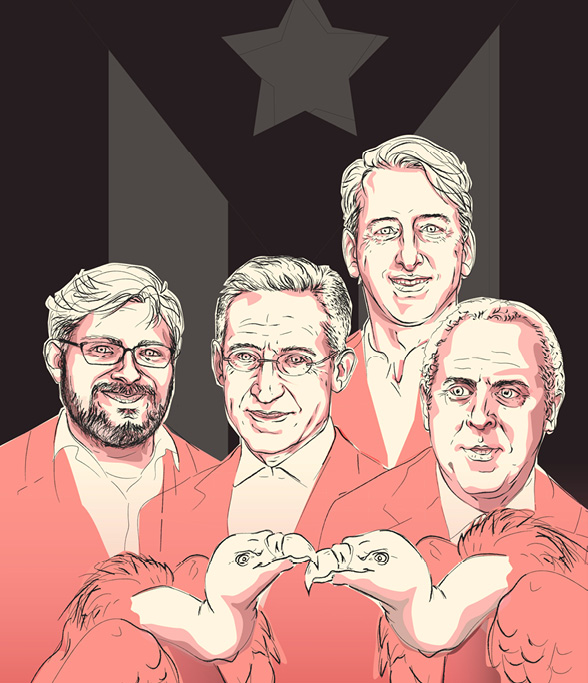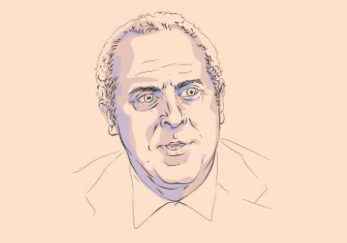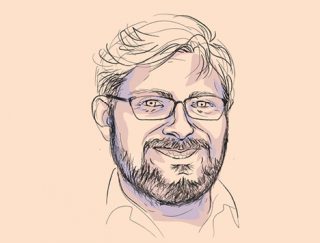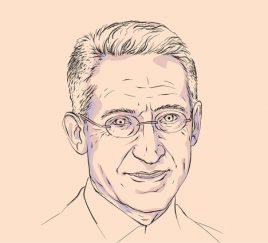

Pain and Profit – Rosselló is gone but vultures still prey on Puerto Rico
Over the past month, Puerto Ricans have risen up in historic numbers to reject the old political and economic order overseen by a corrupt local elite that prioritizes its own interests and Wall Street profits over the Puerto Rican people. The mass mobilizations succeeded in forcing the resignation of Governor Ricardo Rosselló, sending the government into a state of upheaval, and making it impossible for it to ignore the people-powered demands achieving broad consensus across the island and diaspora.
In this context, Wall Street is still angling to extract as much profit out of the debt restructuring process overseen by the unelected federal oversight board as possible. This report names some of the vulture funds who are speculating most heavily on Puerto Rico’s debt and standing in the way of the progress that the movement is demanding – a just recovery, adequate funding of essential services, and a democratic and accountable government.
Introduction:
Puerto Rico is in the midst of the worst institutional crisis in its recent history. Corruption scandals, arrests of public officials by federal authorities, and the publication of leaked chats have galvanized a mass movement demanding governor Ricardo Rossello’s resignation. After two weeks of nonstop country-wide protests, street battles with police, and the capitulation of the governor’s own political party, Rosselló was forced to resign on July 24, effective on August 2 – a major victory for the people.
Pedro Pierluisi, former resident commissioner and legal advisor for the oversight board, succeeded him. Serious questions about his conflicts of interest and the legality of his appointment were raised from the outset.[1] Then, on August 7th, Puerto Rico’s Supreme Court ruled that Pierluisi’s governorship was unconstitutional.[2] Secretary of Justice, Wanda Vázquez, assumed the position.
This comes in the context of a 13 year-long economic depression, three years since the approval of the Puerto Rico Oversight, Management, Economic, and Stability Act (PROMESA) and its imposition of the oversight board, and almost two years after Hurricane María.
Wave after wave of austerity measures have worsened Puerto Ricans’ living conditions, including:
- The closing of over 400 hundred of public schools. Under the oversight of Secretary of Education Julia Keleher, with the approval of Rosselló and the oversight board, the government closed over 400 public schools and approved a law to implement a system of charter schools. Now the mastermind behind this disaster, Keleher, is under indictment by federal authorities for wire fraud conspiracy, theft, and money laundering.[3]
- The slashing of half the budget of the University of Puerto Rico. The cuts were so deep that UPR was on the verge of losing its accreditation to the Middle States Commission on Higher Education, the non-profit that evaluates universities to see if they comply with quality standards. The oversight board also ordered a hike in the cost of credits, doubling the cost of bachelor’s programs in just two years.
- Drastic cuts to the municipalities’ budgets. The oversight board has already cut $150 million in central government appropriations to the municipalities. Its latest certified fiscal plan envisions another cut of $220 million by 2024.[4] Municipalities are the most direct providers of essential services to the people.
All of these attacks have the same purpose: save more money to pay bondholders, particularly vulture funds, through debt restructuring agreements that fill the pockets of Wall Street billionaires.
Although the government is in complete disarray, the Title III bankruptcy proceedings continue. The Puerto Rico Fiscal Agency and Financial Advisory Authority (AAFAF by its Spanish acronym), the agency that represents the local government before bondholders, currently has no CEO. Christian Sobrino, its previous CEO, resigned due to his participation in the infamous chat. Its successor also resigned less than a week after his appointment.
On July 24 Judge Laura Taylor Swain stayed all litigating matters which have an impact on the Commonwealth’s debt adjustment plan that the oversight board is trying to file.[5] Particularly, disputes around the challenged bonds were stayed and a mandatory mediation process was opened until November 30th. In the meantime, the government is still in disarray, with a political crisis unfolding regarding who will definitely succeed Rosselló. With a new governor, Wanda Vázquez, without legitimacy for covering up the corruption cases of the Rosselló administration, plus a fiscal agent, AAFAF, that has no leader currently, Judge Swain should stay all bankruptcy proceedings until the local government reorganizes again.
- The Vultures
While the political crisis in Puerto Rico continues, vulture funds don’t rest in their quest to squeeze as much profit as they can. Vulture funds are poised to continue to profit. Currently, there are two debt adjustment plans being negotiated. First, there is the Puerto Rico Electric Power Authority’s (PREPA) plan, where the oversight board reached a preliminary agreement with a group of vulture funds. The agreement proposes an imposition of a “transition charge”, a regressive tax in clients’ light bills with the sole purpose of paying the debt.[6]
Second, there is the Commonwealth’s (central government) plan, where the oversight board also reached a preliminary agreement with a group of vulture funds.[7] In the agreement, the oversight board is willing to pay bondholders that hold legally challenged bonds. In January, the oversight board questioned the legality of $6 billion of Commonwealth bonds on the grounds that they violated the constitutional debt limit. By the summer that number increase to over $9 billion. Now they are proposing to pay for that debt, and leave the question of their legality out of the deal.
We present here some of the top vulture funds profiting at the expense of Puerto Ricans:
GoldenTree Asset Management
$2.6 billion in COFINA, HTA, PREPA, and Commonwealth debt

GoldenTree is one of the most aggressive vulture funds taking advantage of Puerto Rico’s debt crisis. It has invested heavily in all kinds of Puerto Rico bonds, including bonds from COFINA, PREPA, and the Commonwealth.
- Steve Tananbaum, billionaire founder
- Over a quarter-billion dollars in profit from Puerto Rico’s pain
- Ten-million-dollar sculptures
- $23 million dollar apartment
- Trustee of the Museum of Modern Art]
GoldenTree secured a great deal when judge Swain approved the COFINA debt adjustment plan. As part of the COFINA Senior Bondholders Group, GoldenTree reported having $1.8 billion in COFINA bonds in November 2018, all of which were bought when Puerto Rico bonds’ prices plummeted.[8]
Since GoldenTree is no longer required to disclose its COFINA holdings following the February restructuring of the debt, the above total of $2.6 billion includes the $1.8 billion in COFINA debt it disclosed in November 2018, its last such disclosure. The total figure also includes $760,813,000 in other investments most recently disclosed in July 2019 and discussed below.
GoldenTree is the vulture fund that took the most advantage of the destruction wrought by Hurricane Maria.
While allegedly sending planes to help people, GoldenTree went on a buying spree of COFINA subordinated bonds, the prices of which plummeted dramatically for some months after Maria.[9] GoldenTree brought over $408 million from October 2017 to April 2018. Just in its investments after Maria in COFINA subordinated bonds, GoldenTree made an estimated $159 million.[10]
From its investments in COFINA senior bonds overall it made an estimated $278 million in profits (these numbers are likely conservative – it is ultimately impossible to know how much the fund made, absent full public disclosure). All of this was possible because of the restructuring agreement the oversight board signed with the bondholders.
GoldenTree is also well positioned to profit hugely from its investments in the Commonwealth’s bonds. As of June 2019, it reported having over $383 million in holdings.[11] It is part of the Lawful Constitutional Group, a coalition of vulture funds whose members include several of the same ones who were members of the COFINA Seniors Coalition and profited heavily in the COFINA deal.
A hike in PREPA’s clients light bills will also mean immense profits for GoldenTree. As of May 2019, it reported having over $358 million in PREPA bonds.[12]
GoldenTree also signed a deal with AAFAF to restructure the debt of the Puerto Rico Industrial Development Company (PRIDCO). GoldenTree held over two-thirds of the outstanding bonds, or around $176 million.[13]
GoldenTree was founded by Steven Tananbaum, a billionaire art collector who sits on the board of trustees of the Museum of Modern Art (MoMa) in New York City.[14] He owns between 25% and 50% of the firm, according to SEC disclosures.[15]
Tananbaum spends millions on his art collection. For example, it was revealed in a lawsuit filed in 2018 that Tananbaum spent $10.9 million on two sculptures from artist Jeff Koons.[16]
In 2013 Tananbaum and his wife, bought a 14-room apartment on Park Avenue in New York City, for $23 million.[17] Monthly maintenance fees are over $17,000.
By contrast, Puerto Rico’s median household income between 2013 and 2017 was $19,775.[18]
Autonomy Capital
$1.134 billion in GO debt
 Autonomy Capital is the vulture fund with the largest holdings in general obligation bonds. As of March 2019 it had $1.1 billion.[19]
Autonomy Capital is the vulture fund with the largest holdings in general obligation bonds. As of March 2019 it had $1.1 billion.[19]
- Robert Gibbins, founder
- Demanding hurricane recovery funds be paid to hedge funds
- Scandal-plagued fund manager sued by mistress
- Huge landowner in Brazil & Paraguay
- Seeking massive profits from climate disasters]
The Center for Investigative Journalism (CPI) reported that after Maria, Autonomy Capital, as part of the Ad Hoc Group of General Obligation Bondholders, raised several objections to the oversight board and the local government’s request for a court order to protect upcoming federal recovery fund payments. The request sought to ensure that those funds would be used with the sole purpose of reconstruction and recovery.[20]
The vulture funds’ (and Autonomy’s) objection said “Federal reimbursement funds,” with which the government replaces its expenses in the emergency, “should not be excluded from creditors’ claims, liens, or priorities, because they merely replace funds previously spent by the Commonwealth from its own resources for the purposes designated in the federal program.”[21]
Autonomy Capital was founded in 2003 by Robert Gibbins. He has a stake of over 75% in the firm, meaning that two thirds or more of the performance fees Autonomy collects on its Puerto Rico investments will go to his pockets, in addition to the profit on his share of those investments.[22]
He sits on the board of directors of Brasilagro Companhia Brasileira de Propriedades Agricolas, a rural real estate firm based in Brazil which also produces soy, sugarcane, corn, and livestock.[23] Autonomy is the second largest shareholder, with over 14% of the shares.[24] Brasilagro is a significant landowner, owning 266,772 hectares in several states of Brazil and Paraguay.
Gibbins has recently talked about how investors should be aware of climate change. Business magazine Forbes quotes him as saying: “Climate change is something we have to include in every single analysis, every investment”. He believes that carbon will become a costly waste product, and so he has already invested in carbon-future contracts in Europe.[25]
Mason Capital
$914,320,777 in ERS and Commonwealth debt
Mason Capital stands as the most active buyer of pension bonds. In a year and a half, from August 2017 to February 2019 – as Puerto Rico reeled from the devastation of Hurricane Maria – it tripled its investments in pension bonds, with total holdings around $439 million.[26] Mason is also well positioned to profit from the upcoming Commonwealth debt adjustment plan. As of July 2019, it reported over $465 million in Commonwealth’s bonds.[27]

- Ken Garschina, cofounder
- Biggest buyer of Puerto Rico pension bonds
- 500-acre Texas ranch with llamas
- $5.4 million Manhattan mansion
- Plays elephant polo in Thailand]
Mason Capital was cofounded in 2000 by Kenneth Garschina. Garschina is a member of the board of trustees of the Manhattan Institute, a New York City-based conservative think tank known for pushing cuts in public spending and pensions.[28] He can fund these type of projects because of his Mason profits, where he owns between 50% and 75% of the firm.[29]
Garschina, along with his wife Sara Story, an interior designer, owns a 500-acre ranch in Texas which boasts seven bedrooms, a tennis court, a cedar pavilion, horsehair walls, and an infinity pool with its own glass house. The ranch has llamas, sheep, turkeys, javelinas, and white-tailed deer.[30]
Garschina and Story also have a townhouse in Gramercy Park in New York City, where they regularly throw parties featuring items like $1,000 candlesticks, $300 dishes, and $250 personal florals.[31] The family also loves to play elephant polo in Thailand.[32]
Canyon Capital
$940,493,020 in COFINA, GO, and HTA debt
Canyon Capital is another vulture fund well positioned to profit from the upcoming Commonwealth’s debt adjustment plan. It more than doubled its holdings in general obligation bonds since the start of the bankruptcy, from over $321 million in August 2017 to $687 million in June 2019, making Canyon one of the largest holders of GOs.[33]
Canyon made around $93 million in profits following the approval of the COFINA debt adjustment plan in February; it had $246 million in total COFINA holdings as of its November 2018 disclosure.[34]

- Joshua Friedman, cofounder
- Explosive short-term profits from Puerto Rico’s pain
- $24 million mansion in California
- Board member, LA County Museum of Art (LACMA)]
Canyon Capital was cofounded in 1990 by Joshua Friedman. Along with his wife Beth Friedman, they have in their names various trusts with controlling power of the company, which has around $22.4 billion in assets under management.[35]
Friedman owns a $24 million mansion in Santa Barbara County, California.[36] The seven-bedroom, six-bathroom property has two garages that measure 882 and 994 feet, respectively, a pool cabana, a guest house, and a studio.[37]
Friedman is a member of several boards of trustees, including the California Institute of Technology, and the Andrew W. Mellon Foundation.[38] Friedman is also interested in art, being a member of the board of trustees of the Los Angeles County Museum of Art (LACMA).[39]
III. Conclusion:

As a new movement forms in Puerto Rico, tired of corruption and government abuses, activists should not forget about the impact that vulture funds have had on the recovery of the island – and in redirecting funds that could be used to pay for essential services into their own pockets and to pay for their lavish lifestyles.
After the dust settles and Puerto Rico finally ends with a new governor, the oversight board, with their debt adjustment plans, will still be in place. Now more than ever there is an opportunity to bring accountability to the corporations and vulture funds that have worked with the former governor and the oversight board to advance a regime of austerity and privatization for Puerto Rico to ensure they profit.
[1] https://news.littlesis.org/2019/08/05/pedro-pierluisi-the-vulture-governor/?preview=true&_thumbnail_id=10452
[2] https://www.metro.pr/pr/noticias/2019/08/07/tribunal-supremo-anula-gobernacion-de-pedro-pierluisi.html
[3] https://www.documentcloud.org/documents/6187031-Ind-7-10-19-Public-Corruption-19-431-PAD.html#document/p1
[4] Certified as of May 9 2019_Fiscal Plan for Commonwealth of Puerto Rico.pdf
[5] https://cases.primeclerk.com/puertorico/Home-DownloadPDF?id1=OTE4NDM5&id2=0
[6] https://emma.msrb.org/ER1221933-ER956373-ER1357358.pdf
[7] https://drive.google.com/file/d/1vVUT722_ai0VOfrzYbEwWHCwzhsMrvWH/view
[8] https://cases.primeclerk.com/puertorico/Home-DownloadPDF?id1=ODk5ODcw&id2=0
[9] Check minute 4:35: https://www.youtube.com/watch?v=ChS4Fb_gQaE
[10] https://news.littlesis.org/2018/11/20/the-cofina-agreement-part-2-profits-for-the-few/
[11] https://cases.primeclerk.com/puertorico/Home-DownloadPDF?id1=OTE0NDkx&id2=0
[12] https://cases.primeclerk.com/puertorico/Home-DownloadPDF?id1=OTExNzgx&id2=0
[13] https://caribbeanbusiness.com/puerto-rico-industrial-development-co-enters-tentative-deal-to-restructure-165-million/
[14] https://www.moma.org/about/trustees
[15] https://www.adviserinfo.sec.gov/IAPD/content/viewform/adv/Sections/iapd_AdvScheduleASection.aspx?ORG_PK=112753&FLNG_PK=017756C2000801A2053C550101B9CE91056C8CC0
[16] https://news.artnet.com/art-world/collector-sues-jeff-koons-and-gagosian-gallery-1269605
[17] https://cityroom.blogs.nytimes.com/2013/07/05/big-ticket-14-rooms-on-park-avenue-for-23-million/?mtrref=www.google.com&assetType=REGIWALL
[18] https://www.census.gov/quickfacts/fact/table/PR/INC110217#INC110217
[19] https://cases.primeclerk.com/puertorico/Home-DownloadPDF?id1=OTA1NDUx&id2=0
[20] http://periodismoinvestigativo.com/2017/10/old-colleagues-gather-in-a-group-that-requires-puerto-rico-to-pay-the-debt/
[21] https://cases.primeclerk.com/puertorico/Home-DownloadPDF?id1=NzExMTU1&id2=0
[22] https://www.adviserinfo.sec.gov/IAPD/content/viewform/adv/Sections/iapd_AdvScheduleASection.aspx?ORG_PK=157275&FLNG_PK=057D1086000801A60455777101F4888D056C8CC0
[23] http://www.brasil-agro.com/conteudo_en.asp?idioma=1&conta=44&tipo=36905
[24] http://www.brasil-agro.com/conteudo_en.asp?idioma=1&conta=44&tipo=36900
[25] https://www.forbes.com/sites/nathanvardi/2019/05/29/robert-gibbins-autonomy-capital/#621b1a18507d
[26] August 2017: https://cases.primeclerk.com/puertorico/Home-DownloadPDF?id1=NzAxMjEz&id2=0; February 2019: https://cases.primeclerk.com/puertorico/Home-DownloadPDF?id1=OTA0MzMy&id2=0
[27] https://cases.primeclerk.com/puertorico/Home-DownloadPDF?id1=OTE3MTY2&id2=0
[28] https://www.manhattan-institute.org/board-of-trustees
[29] https://www.adviserinfo.sec.gov/IAPD/content/viewform/adv/Sections/iapd_AdvScheduleASection.aspx?ORG_PK=158797&FLNG_PK=05599DEA000801A303010B0101C35A51056C8CC0
[30] https://www.papercitymag.com/real-estate/the-story-of-sara/
[31] https://www.harpersbazaar.com/culture/interiors-entertaining/g10263056/sara-story-stylish-dining-tips/
[32] https://myemail.constantcontact.com/The-Elephant-Story-Blog-Update–The-Third-Annual-Elephant-Story-Invitational-Elephant-Polo-Tournament–June-16-18-Moo-Baan-Chang.html?soid=1111568351599&aid=jmh3FP6gGMQ
[33] August 2017: http://cases.primeclerk.com/puertorico/DownLoad-DownloadPDF?id1=ODkzMzIy&id2=0&id3=0; June 2019 https://cases.primeclerk.com/puertorico/Home-DownloadPDF?id1=OTE1NTUw&id2=0
[34] https://news.littlesis.org/2018/11/20/the-cofina-agreement-part-2-profits-for-the-few/
[35] Assets under management: https://www.adviserinfo.sec.gov/IAPD/Content/Common/crd_iapd_Brochure.aspx?BRCHR_VRSN_ID=559769; ownership: https://www.adviserinfo.sec.gov/IAPD/content/viewform/adv/Sections/iapd_AdvScheduleBSection.aspx?ORG_PK=107922&FLNG_PK=0431819E000801A702B61F5101FFA385056C8CC0
[36] http://sbcassessor.com/assessor/details.aspx?apn=007100007
[37] Note Beth Friedman’s name and property information in the first document and compare with the second document: http://sbcountyplanning.org/PDF/boards/subdivis/05-15-2014/05-15-14%20%20SDRC%20SPC%20Agenda.pdf ; and http://sbcountyplanning.org/PDF/boards/mbar/08-13-2012/8-13-12.pdf
[38] California Institute of Technology: http://bot.caltech.edu/trustees; Andrew M. Mellon Foundation: https://mellon.org/about/trustees/
[39] https://www.lacma.org/about#leadership

